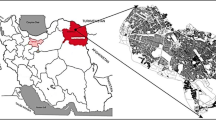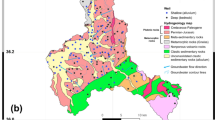Abstract
Acid mine drainage (AMD) is a global problem that may have serious human health and environmental implications. Laboratory and field tests are commonly used for predicting AMD, however, this is challenging since its formation varies from site-to-site for a number of reasons. Furthermore, these tests are often conducted at small-scale over a short period of time. Subsequently, extrapolation of these results into large-scale setting of mine sites introduce huge uncertainties for decision-makers. This study presents machine learning techniques to develop models to predict AMD quality using historical monitoring data of a mine site. The machine learning techniques explored in this study include artificial neural networks (ANN), support vector machine with polynomial (SVM-Poly) and radial base function (SVM-RBF) kernels, model tree (M5P), and K-nearest neighbors (K-NN). Input variables (physico-chemical parameters) that influence drainage dynamics are identified and used to develop models to predict copper concentrations. For these selected techniques, the predictive accuracy and uncertainty were evaluated based on different statistical measures. The results showed that SVM-Poly performed best, followed by the SVM-RBF, ANN, M5P, and KNN techniques. Overall, this study demonstrates that the machine learning techniques are promising tools for predicting AMD quality.





Similar content being viewed by others
References
Allison, J.D., Brown, D.S. & Novo-Gradac, K.J. (1991). MINTEQA2/PRODEFA2- user's manual (version 3.0). A geochemical assessment model for environmental systems. U.S. Environmental Protection Agency, Athens, GA. EPA/600/3-91/021.
Azapagic, A. (2004). Developing a framework for sustainable development indicators for the mining and minerals industry. Journal of Cleaner Production, 12, 639–662.
Bishop, C.M. (1995). Neural networks for pattern recognition. Oxford: Clarendon.
Bouckaert, R.R., Frank, E., Hall, M., Kirkby, R., Reutemann, P., Seewald, A., et al. (2010). WEKA manual (version 3.6.4). Hamilton: University of Waikato.
Cherkassky, V.S., & Mulier, F. (2007). Learning from data: concepts, theory, and methods. New Jersey: Wiley.
Cherkassky, V., Krasnopolsky, V., Solomatine, D., & Valdes, J. (2006). Computational intelligence in earth sciences and environmental applications: issues and challenges. Neural Networks, 19, 113–121.
Gray, N.F. (1996). Field assessment of acid mine drainage contamination in surface and ground water. Environmental Geology, 27, 358–361.
Hargreaves, G., & Riley, J. (1985). Agricultural benefits for Senegal River basin. Journal of Irrigation Drainage, E-ASCE, 111, 113–124.
Khndelwal, M., & Singh, T.N. (2005). Prediction of mine water quality by physical parameters. Journal of Scientific and Industrial Research, 64, 564–570.
Maest, A.S., Kuipers, J.R., Travers, C.L., & Atkins, D.A. (2005). Predicting water quality at hardrock mines: methods and models, uncertainty and state-of-the-art. Montana: Kuipers & Associate.
Mitchell, T. (1997). Machine learning. New York: McGraw-Hill.
Morin, K.A., & Hutt, N.M. (1993). The use of routine monitoring data for assessment and prediction of water chemistry. In Proceedings of the 17th Annual Mine Reclamation Symposium of Mining Association of British Columbia, Port Hardy, BC, Canada.
Morin, K.A., & Hutt, N.M. (1994). An empirical technique for predicting the chemistry of water seeping from mine-rock piles. In Proceedings of the international conference on the Abatement of Acidic Drainage. Pittsburgh, PA, USA.
Morin, K.A., & Hutt, N.M. (1997). Environmental geochemistry of minesite drainage: practical theory and case studies. Vancouver: MDAG Publishing.
Morin, K.A., & Hutt, N.M. (2001). Prediction of minesite-drainage chemistry through closure using operational monitoring data. Journal of Geochemical Exploration, 73(200), 123–130.
Morin, K.A., Hutt, N.M. & Horne, I.A. (1995). Prediction of future water chemistry from Island Copper Mine's On-Land Dumps. In 19th Annual British Columbia Mine Reclamation Symposium. Dawson Creek, BC, Canada.
Morin, K.A., Hutt, N.M. & Aziz, M.L. (2010). Twenty-three years of monitoring minesite-drainage chemistry, during operation and after closure: the Equity Silver Minesite, British Columbia, Canada. Available at http://www.mdag.com/case_studies/MDAG-com Case Study 35-23 Years of Minesite-Drainage Chemistry at Equity Silver Minesite.pdf. Accessed 13 August 2011.
Palisade Corporation Inc. (2005). Guide to using @RISK. Advanced risk analysis for spreadsheets. New York: Palisade Corporation.
Parkhurst, D.L., & Appelo, C.A. J. (1999). User’s guide to PHREEQC (version 2.18.0). A computer program for speciation, batch reaction, one-dimensional transport and inverse geochemical calculations. U.S. Geological Survey Water Resources Investigation, Report 99–4259.
Perkins, E.H., Nesbitt, H.W., Gunter, W.D., St-Arnaud, L. C., Mycroft, J. R., et al. (1995). Critical Review of Geochemical Processes and Geochemical Models Adaptable for Prediction of Acidic Drainage from Waste Rock. Canadian Mine Environment Neutral Drainage (MEND). Report 1.42.1.
Price, W.A. (2009). Prediction Manual of Drainage Chemistry from Sulphidic Geologic Materials. Canadian Mine Environment Neutral Drainage (MEND). Report 1.20.1.
Quinlan, J.R. (1992). Learning with continuous classes. In Proceedings of the 5th Australian Joint Conference on Artificial Intelligence, Singapore.
Reich, Y. (1997). Machine learning techniques for civil engineering problems. Microcomputer in civil engineering, 12, 295–310.
Reich, Y., & Barai, S.V. (1999). Evaluating machine learning models for engineering problems. Artificial Intelligence in Engineering, 13(3), 257–272.
Scharer, J.M., Annable, W.K., & Nicholson, R.V. (1993). WATAIL-User’s Manual(version1.0). A tailings basin model to evaluate transient water quality of acid mine drainage. Institute of Groundwater Research, University of Waterloo.
Smola, A.J. & Schölkopf, B. (1998). A tutorial on support vector regression. Report 1998-030, Royal Holloway College, London
Solomatine, D.P., & Ostfeld, A. (2008). Data-driven modelling: some past experiences and new approaches. Journal of Hydroinformatics, 10(1), 3–22.
USEPA (1994). Technical document of acid mine drainage prediction. Washington: Office of Solid Waste. Report EPA530-R-94-036.
Vapnik, V. (1995). The Nature of statistical learning theory. New York: Springer.
Vapnik, V. (1998). Statistical learning theory. New York: Willey.
Walter, A.L., Frind, E.O., Blowes, D. W., Ptacek, C.J., Molson, J. W., et al. (1994). Modelling of multicomponent reactive transport in groundwater 1. Model development and evaluation. Water Resources Research, 30(11), 3137–3148.
Wang, Y. & Witten, I. (1997). Inducing model trees for continuous classes. In Poster Papers of the 9th European Conference on Machine Learning.
William, W.H. (2009). Machine learning methods in the environmental sciences: neural networks and kernels. Cambridge: Cambridge University Press.
Witten, I.H., & Frank, E. (2005). Data mining: practical machine learning tools and techniques. San Francisco: Morgan Kaufmann.
Acknowledgments
This research has been carried out as a part of NSERC-DG (Discovery Grant) funded by Natural Sciences and Engineering Research Council of Canada (NSERC). We also like to thank Minesite Drainage Assessment Group (MDAG) for providing valuable data to test various models.
Author information
Authors and Affiliations
Corresponding author
Rights and permissions
About this article
Cite this article
Betrie, G.D., Tesfamariam, S., Morin, K.A. et al. Predicting copper concentrations in acid mine drainage: a comparative analysis of five machine learning techniques. Environ Monit Assess 185, 4171–4182 (2013). https://doi.org/10.1007/s10661-012-2859-7
Received:
Accepted:
Published:
Issue Date:
DOI: https://doi.org/10.1007/s10661-012-2859-7




